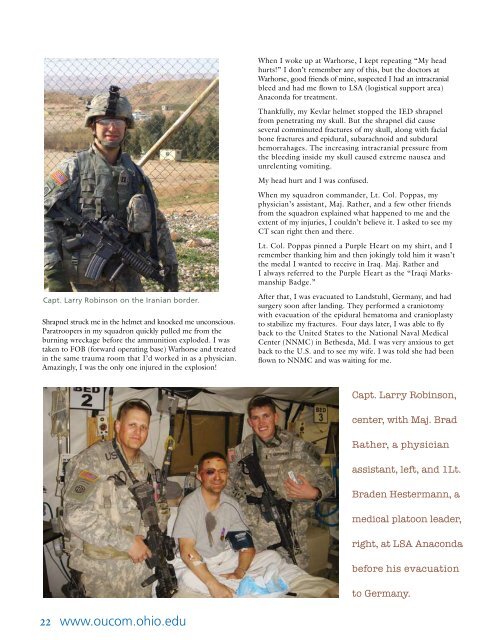DO - Ohio University College of Osteopathic Medicine
DO - Ohio University College of Osteopathic Medicine
DO - Ohio University College of Osteopathic Medicine
Create successful ePaper yourself
Turn your PDF publications into a flip-book with our unique Google optimized e-Paper software.
When I woke up at Warhorse, I kept repeating “My head<br />
hurts!” I don’t remember any <strong>of</strong> this, but the doctors at<br />
Warhorse, good friends <strong>of</strong> mine, suspected I had an intracranial<br />
bleed and had me flown to LSA (logistical support area)<br />
Anaconda for treatment.<br />
Thankfully, my Kevlar helmet stopped the IED shrapnel<br />
from penetrating my skull. But the shrapnel did cause<br />
several comminuted fractures <strong>of</strong> my skull, along with facial<br />
bone fractures and epidural, subarachnoid and subdural<br />
hemorrahages. The increasing intracranial pressure from<br />
the bleeding inside my skull caused extreme nausea and<br />
unrelenting vomiting.<br />
My head hurt and I was confused.<br />
When my squadron commander, Lt. Col. Poppas, my<br />
physician’s assistant, Maj. Rather, and a few other friends<br />
from the squadron explained what happened to me and the<br />
extent <strong>of</strong> my injuries, I couldn’t believe it. I asked to see my<br />
CT scan right then and there.<br />
Lt. Col. Poppas pinned a Purple Heart on my shirt, and I<br />
remember thanking him and then jokingly told him it wasn’t<br />
the medal I wanted to receive in Iraq. Maj. Rather and<br />
I always referred to the Purple Heart as the “Iraqi Marksmanship<br />
Badge.”<br />
Capt. Larry Robinson on the Iranian border.<br />
Shrapnel struck me in the helmet and knocked me unconscious.<br />
Paratroopers in my squadron quickly pulled me from the<br />
burning wreckage before the ammunition exploded. I was<br />
taken to FOB (forward operating base) Warhorse and treated<br />
in the same trauma room that I’d worked in as a physician.<br />
Amazingly, I was the only one injured in the explosion!<br />
After that, I was evacuated to Landstuhl, Germany, and had<br />
surgery soon after landing. They performed a craniotomy<br />
with evacuation <strong>of</strong> the epidural hematoma and cranioplasty<br />
to stabilize my fractures. Four days later, I was able to fly<br />
back to the United States to the National Naval Medical<br />
Center (NNMC) in Bethesda, Md. I was very anxious to get<br />
back to the U.S. and to see my wife. I was told she had been<br />
flown to NNMC and was waiting for me.<br />
Capt. Larry Robinson,<br />
center, with Maj. Brad<br />
Rather, a physician<br />
assistant, left, and 1Lt.<br />
Braden Hestermann, a<br />
medical platoon leader,<br />
right, at LSA Anaconda<br />
before his evacuation<br />
to Germany.<br />
22 www.oucom.ohio.edu
















